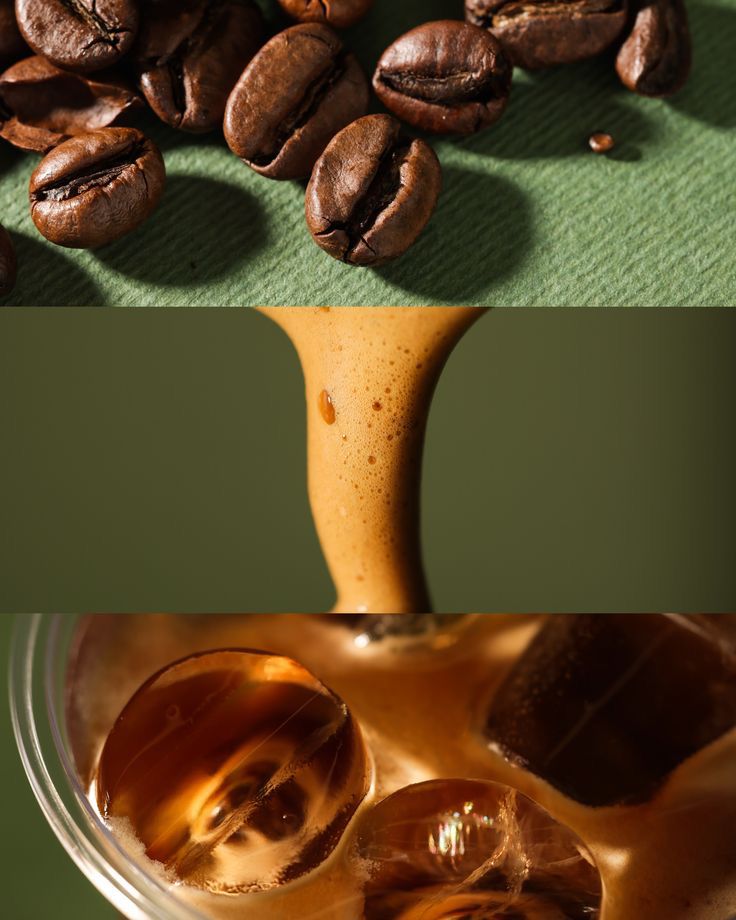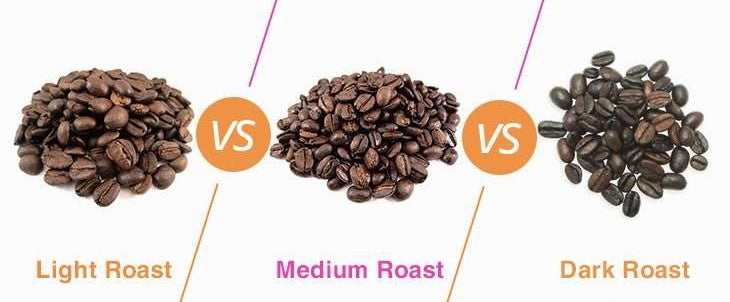I. Introduction
A. Definition of coffee roasting
Coffee roasting is the process of taking raw, green coffee beans and roasting them to produce their unique flavor. The roast level--light, medium, or dark--affects the flavor characteristics of each blend of coffee.
The temperature used for roasting and the length of time it takes to roast will determine how much flavor is extracted from the bean. The darker the roast, the more intense the flavors become; light roasts result in a sweeter and milder cup of coffee, while dark roasts are smoky, and earthy, with a hint of bitterness.
Understanding the differences between light, medium, and dark-roast coffees can help you determine which type suits your tastes best. With so many different roast levels out there, it is no wonder why coffee lovers debate over which style is their favorite!
B. Importance of coffee roasting in determining coffee taste and flavor
The process of roasting coffee beans is one of the most important steps in creating your favorite cup of coffee. How it is roasted determines the taste, aroma, and overall flavor characteristics of each blend.
Light-roast coffees are roasted at a lower temperature for a shorter time, resulting in a milder cup with sweet and fruity flavors. The beans will be lighter in color and have less body than those of medium or dark roasts.
Medium-roast coffees are roasted at a higher temperature for longer periods, creating a deep, robust flavor with notes of chocolate, spices, and nuts. These beans have more body than light-roast coffees but still, retain a good deal of acidity for balance.
Darker roasts are roasted at the highest temperatures for the longest periods. This produces very dark-colored beans that are bold, smoky, and earthy with low acidity — think caramel and chocolate tones amidst smoky flavors!
Next time you are enjoying your favorite cup of coffee, consider how it was roasted to bring out its unique flavors!
C. Overview of the different roast levels
When it comes to coffee, understanding the different roast levels can help you find your favorite flavor. Here is a brief overview of the three most common roast levels:
Light Roast – Lightly roasted beans have been heated for a shorter period and at a lower temperature, resulting in a milder cup with sweet and fruity flavors. The beans will be lighter in color and less oily than darker roasts.
Medium Roast – Medium roasted coffees are roasted at higher temperatures for longer periods, resulting in deep, robust flavors with notes of chocolate, spices, and nuts. These beans will have more body than light-roast coffees, but they also retain good acidity for balance.
Dark Roast – Dark-roasted coffee is roasted at the highest temperatures for the longest periods. This creates very dark-colored beans that are bold, smoky, and earthy with low acidity — think of caramel and chocolate tones amidst smoky flavors!
II. Light Roast
A. Characteristics
1. Light color
Light-roast coffee has a light color, ranging from pale yellow to light brown. This is because the beans are roasted for a shorter period at lower temperatures, preventing them from becoming overly caramelized. The light color of the beans also reflects in the cup, giving one a mild and bright cup with sweet flavors.of time
2. Low oil content
Light-roast coffee has a lower oil content compared to darker roasts, because the beans are roasted at lower temperatures and are not exposed to higher temperatures that develop oils on the surface. As a result, the cup is less oily than darker-roasted coffees since most of the oils remain in the bean during roasting, giving you a clean and crisp cup of coffee.
3. High acidity
Light roast coffee has higher acidity compared to darker roasts because the beans are roasted at a lower temperature, which allows more of the natural acids and flavors to remain in the cup. The light roast yields a bright, vibrant cup with intense flavors and heightened acidity that can be quite acidic on the tongue.
4. Light body
Light-roast coffee has a light body compared to darker roasts. This is because lower temperatures during the roasting process allow fewer oils and solids to be released from the beans, resulting in a thin and watery cup with smooth tones and subtle richness. The light roast will offer you a cup with bright flavors without being too heavy or overpowering on the palate.
B. Flavor profile
1. Bright and tangy
Light-roast coffee has bright and tangy notes that make it an ideal choice for those wanting to enjoy a light cup with subtle complexity. These notes originate from unique flavor compounds found in the bean, which are brought out through low-temperature roasting. Light-roast coffee can have flavors such as citrus and berry, giving a sparkling sensation in your mouth. The bright and tangy notes can be savored with each sip, making them a great way to start the day.
2. Fruity and floral notes
Light-roast coffee has a flavor profile that is often described as fruity and floral. These notes are derived from the bean itself, usually due to its origin or type of roast. Fruity notes can range from sweet citrus fruits to tart berries, giving an array of flavors to explore in one's cup. Floral notes can vary from subtle jasmine and lavender to bright tropical blossoms, providing an additional dimension of complexity that is sure to delight.
3. Lacks the bitter taste of darker roasts
Light roast coffee is a great go-to for those who don't want the bitter taste that can come from darker roasts. Low-temperature roasting locks in the light and fruity notes of the bean, allowing one to enjoy their cup without bitterness. This means one can get a smooth cup that isn't too heavy on the palate, making it perfect for drinking throughout the day. So when looking for a light roast with a more complex flavor profile than what one would find in medium or dark roasts, then try out some light roast coffee!
III. Medium Roast
A. Characteristics
1. Medium color
The color of medium-roast coffee beans can vary greatly depending on the type and origin of the beans used. Generally, the color should be light to medium brown with no oil sheen on its surface. Darker brown tones indicate a higher level of roasted flavor, while lighter colors are indicative of milder flavors.
It is also important to note that different brewing methods will affect the color of your finished cup. For example, French press or espresso brewing methods can lead to darker-colored cups, whereas drip methods tend to produce lighter cups.
The key takeaway here is that you should always look for an even roast color when selecting your beans for a consistent and enjoyable cup!
2. Moderate oil content
Medium-roast coffee is distinct from other types of beans because of its moderate oil content, which helps give it a full-bodied flavor profile without the bitterness or harshness associated with darker roasts.
The amount of oil in the beans depends largely on the variety and origin. For example, Brazilian coffee exhibits higher oil content due to its soil type and climate conditions. Similarly, medium roasts from Hawaii have a natural sweetness that can be attributed to their high sugar content.
When selecting your beans, it is important to pay attention to the color and surface sheen. An even color should be present with no oil on the surface; this indicates that you have moderate-roasted beans with a balance between light and dark flavors.
Overall, make sure you carefully select your beans so that you can get all the benefits of medium roast—full-bodied flavor without any excessive bitterness or burnt tastes!
3. Medium acidity
Medium-roast coffee is known for its balanced and even flavor profile, largely due to its moderate acidity level. If a cup of coffee has too much acidity, it can be off-puttingly bitter and sour; on the other hand, too little acidity will make the cup taste flat and dull.
The acidity of your medium roast will depend not only on the beans you select but also on how you brew them. For example, when using an espresso machine, the high pressure leads to a more concentrated extraction of coffee compounds, thereby increasing the brew's acidity. Conversely, drip machines produce a gentler extraction, resulting in lower levels of acidity.
Whatever brewing method you use, look for signs that indicate good-quality beans, such as an even color and no oil sheen on the surface, before selecting them. These are indicators that you're getting well-balanced beans with moderate levels of acidity!
4. Medium body
Medium-roast coffee is prized for its balanced flavor, and one of the main factors contributing to this is its body. When it comes to coffee, the body refers to how heavy or light it feels in your mouth when you take a sip.
If the coffee has too much body or heaviness, it can lead to feelings of fatigue after consumption due to its strong flavors and high caffeine content. On the other hand, if a cup is too light in its body, it will be lacking depth and complexity.
Medium-roast coffee usually has just the right amount of body, providing enough richness without being overpowering. The balance between light and dark also plays a role here; medium roasts display a perfect harmony between these two ends of the spectrum.
So, when selecting your beans, make sure you look for signs that indicate an even color with no oil on their surface; this will ensure that you are getting beans with moderate levels of the body!
B. Flavor profile
1. Smooth and balanced
If you're looking for a perfect balance of intense smoky taste and delicate floral notes, medium-roast coffee is the right choice. The flavor profile achieved by combining light-roasted beans with darker-roasted ones creates an immaculate harmony that will truly delight your palate. That's why many consider it to be their preferred brew because each sip brings them something unique yet familiar at the same time!
Brewing medium-roast coffee also brings out hints of chocolate, nuts, and caramel that are hidden within these beans. This complex yet harmonious mix of flavors creates the perfect balance that many people look for when enjoying a cup of coffee.
When selecting your beans, make sure you don't forget to check their color and surface, as this will indicate whether they have been roasted correctly or not. If done right, you should get just the right amount of body that is neither too heavy nor light, giving you the perfect medium-roast coffee experience!
2. Caramel and chocolate notes
The coffee comes from a combination of both light and dark roasting, allowing it to pick up hints of both flavors. The light-roasted beans provide a sweet, floral taste while the darker roasts bring out an intense smokiness.
When brewed correctly, medium-roast coffee can also have subtle hints of nuts and caramel that add to its complexity. All these combined give you the perfect balance between sweetness and bitterness, making it a favorite among many coffee drinkers!
To get the best flavor out of your medium-roast beans, you should make sure they are evenly colored with no oil on their surfaces. This will ensure that you are getting just the right amount of each flavor profile in each cup for a truly unique experience!
3. Mildly bitter
Medium-roast coffee is known for its slightly bitter but pleasant flavor. This bitterness comes from the light and dark roasts used in the blend, creating an intricate mix of tastes in one cup. The light-roasted beans provide fruity and floral notes, while the darker ones bring out hints of smoky aroma and taste.
Brewing medium-roast coffee brings out flavors of chocolate, nuts, and caramel that balance the bitterness. This combination of sweet and bitter creates a nuanced flavor profile that is enjoyed by many people who are looking for something lighter than traditional dark roast coffee.
When selecting your beans, make sure you don't forget to check their color and surface, as this will indicate whether they have been roasted correctly or not. If done right, you should get just the right amount of body with a mild yet distinctive taste, giving you the perfect medium-roast coffee experience!
IV. Dark Roast
A. Characteristics
1. Dark color
Dark-roast coffee beans are usually a deep brown or black and often have an oily sheen. The darker color is the result of roasting the beans at higher temperatures for a longer period than what produces lighter roasts. This process gives the beans a smoky flavor and a strong aroma.
2. High oil content
Dark roast coffee beans contain more oil than lighter roasts due to the higher roasting temperatures and longer roasting time. This oil is released during brewing, which contributes to a bold flavor, a stronger aroma, and a smooth finish. The increased oil also adds body to the coffee and makes it more viscous when poured.
3. Low acidity
Dark-roasted coffee beans have a lower acid content than lighter roasts, resulting in a less acidic taste and smoother finish. The low acidity also makes dark-roast coffees easier to digest, making them ideal for those who suffer from acid reflux or other digestive issues. Therefore, dark-roast coffee is the perfect choice for those who want a cup of coffee that is both delicious and gentle on their stomachs.
4. Full body
Dark-roasted coffee beans are known for their full-bondedness, providing a rich and flavorful cup of coffee with a strong aroma and smooth finish. This full-bodied quality is due in part to the higher roasting temperatures and longer roasting times that release more oils from the beans. The result is an intense flavor without any bitterness or harsh notes, making it an ideal choice for those who appreciate bold coffee.
B. Flavor profile
1. Bold and intense
Dark-roast coffee is bold and intense, providing a strong flavor that will satisfy even the most discerning coffee lover. This distinct flavor comes from the roasting process, which requires higher temperatures and longer exposure to hot air or flames. During this process, the beans release more oils, resulting in a full body and robust aroma. The taste of dark-roast coffee is smooth with a slight sweetness and subtle hints of flavors such as chocolate or nuts, making it an excellent choice for those looking for an invigorating cup of coffee.
2. Roasted, smoky and nutty notes
Dark-roast coffee has a distinct flavor profile featuring roasted, smoky, and nutty notes. The roasting process is responsible for the intense flavor, with higher temperatures and longer exposure to hot air or flames resulting in oils being released from the beans. These flavorful oils are complemented by a smokiness that brings out flavors of chocolate and nuts, as well as a slight sweetness for an incredibly smooth finish. Dark roasts offer an amazing experience that any coffee lover will surely enjoy.
3. Strong and bitter taste
Dark-roast coffee has a strong, bitter taste that is sure to satisfy any coffee lover. As the beans are roasted at higher temperatures, the oils released add boldness to the flavor. This intense taste can be offset with a slight sweetness for an incredibly smooth cup of coffee. The bitterness is complemented by smokiness, as well as subtle hints of flavors such as chocolate or nuts, making it the perfect choice for those looking for an invigorating cup of Joe.
V. Conclusion
A. Summary of the differences between light, medium, and dark roast coffee
The key differences between light, medium, and dark roast coffee are primarily related to their color, flavor profile, and caffeine content. Light roast beans tend to be lighter in color, have a mild and sweet flavor, and have a subtler caffeine kick. Medium roast beans have an even taste profile with moderate caffeine content. Dark roast coffee beans offer bolder flavors, richer aromas, and an intense caffeine boost.
B. Importance of understanding the differences in choosing the right coffee roast
Understanding the differences between light, medium, and dark roast coffee is essential to make an informed decision when selecting the right type of roast for yourself. Due to the wide variation in flavor profile and caffeine content between roasts, it is important to take the time to educate oneself on the distinctions to find a roast that meets one's personal preferences and expectations best. Furthermore, familiarizing oneself with the characteristics of different types of roasts can give a better appreciation for all of the possibilities that coffee has to offer.
C. Final thoughts and recommendations
When selecting a type of coffee roast, it is important to consider your personal preferences and expectations. If you prefer a mild flavor profile with a light caffeine kick, then opt for light-roast beans. If you want an even taste profile with moderate caffeine content, choose medium-roast beans. For those who want bolder flavors, richer aromas, and an intense caffeine boost, dark roast is the way to go. Ultimately, it's all about finding a coffee that suits your taste and meets your needs!
VI. Additional Resources
A. Recommended coffee brand
For those looking for the best coffee brands and brewing methods to make the most of their daily cup of Joe, visit our shop for a great coffee experience. We also have coffee machines, grinders and brewing tools.
B. Online communities and forums for coffee lovers
For those looking for an online community to share their coffee experiences and knowledge with others, these are some of the best options.


